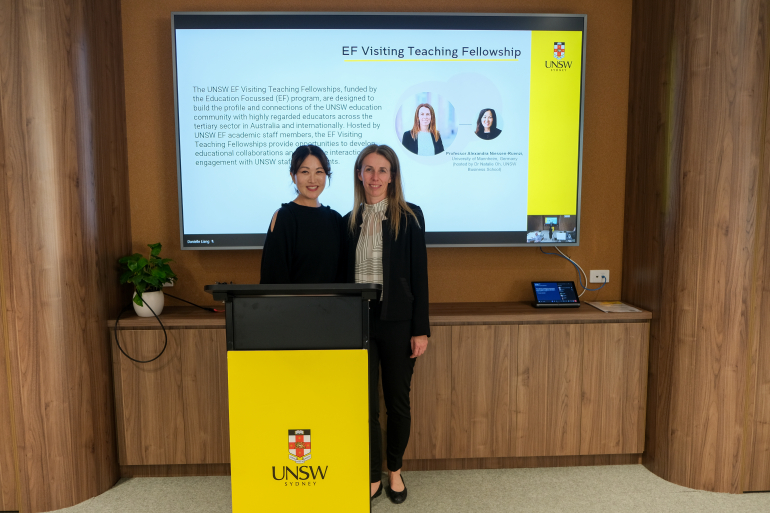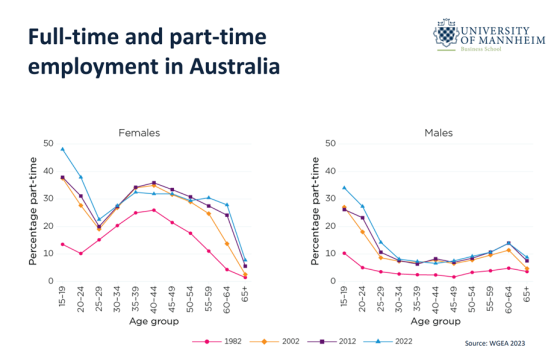By Dr Natalie Oh, School of Banking and Finance
Published 01 July 2024
The initial curiosity that prompted me to ask questions such as "Why is gender equity in the workforce such a long-standing issue with the gender gap not narrowing fast enough?", "When does gender equity start?", and "How am I preparing my students for gender inequality in the workplace?" has evolved into an intriguing educational journey. This spark ignited a research journey that culminated in the development of an interactive online module designed to equip students for the professional world. Furthermore, it led to organizing workshops to educate not only students but also academics and professionals on gender equity in the workforce.
Under the UNSW Education Focussed Visiting Teaching Fellowships program, I had the privilege of hosting Professor Alexandra Niessen-Ruenzifrom the University of Mannheim in Germany, who shared her expertise on gender inequalities in the workforce with UNSW students, academics, and the business community.
In collaboration with numerous dedicated partners, Alexandra and I organised and spoke at the following events:
- Professionals event (Thursday 23rd May): ‘Gender gaps in leadership: Reasons and Remedies’ in partnership with 100 Women in Finance – Breakfast event held at MA Financial Group
- Academic event (Thursday 23rd May): ‘From Barriers to Bridges: Empowering gender equity in academics to better prepare students for employability’ in partnership with UNSW WIL & TED Community of Practice – ‘Lunch & Learn’ for academics and staff.
- Student event (Monday 27th May): ‘Cultivating change’ in partnership with Ernst&Young (EY), CapitalW and Women in Consulting attended by many students and business representatives.
At the student event hosted by EY, we showcased a segment of the educational resource I developed through my research: ‘Awareness to Action: Empowering Gender Equality in the Workforce.’ This module aims to educate UNSW Business students about gender equity issues in partnership with Career Accelerator. UNSW is at the forefront, being among the first to introduce such a module, thereby preparing students for the workforce. Business representatives lauded UNSW’s initiative in developing this curriculum and guiding students on this critical issue.
All events were well attended, with many interesting questions from the audience and fostering insightful discussions. The events not only highlighted the importance of gender equity in the workplace but also provided many practical and actionable insights.
What were the insightful, practical, and actionable insights from Alexandra’s presentation?
Here are the top three challenges contributing to the persistence of gender inequity and why there are no quick fixes, along with some recommendations. All the figures are from Alexandra’s presentation.
Top 3 Challenges
1. Trade-off between career & care: The ‘motherhood gap’ or ‘child penalty’ often leads women to opt for part-time work during their most career-active years. The resulting gap, as depicted in the graph, does not converge over time. For women, part time work is prominent during working age (25-60) whilst men it is the opposite.
2. Navigating non-promotable tasks (NPTs) - NPTs are essential for organisational success but don’t directly contribute to one’s career advancement. Women volunteer for NPTs 48% more often than men. The key takeaway from Alexandra’s talk was to ask ourselves, “Is this task promotable or not?” and to strive for a balance between NPTs and promotable tasks.
3. Backlash and double standards: The ‘gender punishment gap’ presents a dilemma where women face backlash for exhibiting confidence and assertiveness, traits traditionally associated with male leadership.
Recommendations:
- Set measurable targets and encourage cultural change: What gets measured gets managed. Set tangible goals, like increasing female leadership by a specific percentage, and foster a culture that supports these targets.
- Actively support each other. As Madeleine Albright famously said at the WNBA All-Decade team luncheon in 2006, “There’s a special place in hell for women who don’t help each other
- Engage men in the conversation: Diversity and inclusion are not solely women’s issues.
- Balance NPTs and promotable tasks: Remember to weigh the value of tasks and seek balance.
- If all goes wrong… start your own company – The rising trend of female-led startups offers another path to empowerment.
My personal journey through gender equity research has been transformative. Understanding the issues and exploring international solutions has inspired me to take a proactive stance in my career. By creating an educational module, I’ve aimed to prepare students for their future careers and raise awareness among a broader audience. I’m grateful for the opportunities provided by the Visiting Teaching Fellowship through the Education Focussed Program.
Read other UNSW Education blogs or submit your own.
***
Reading this on mobile? Scroll down to learn about the author.



